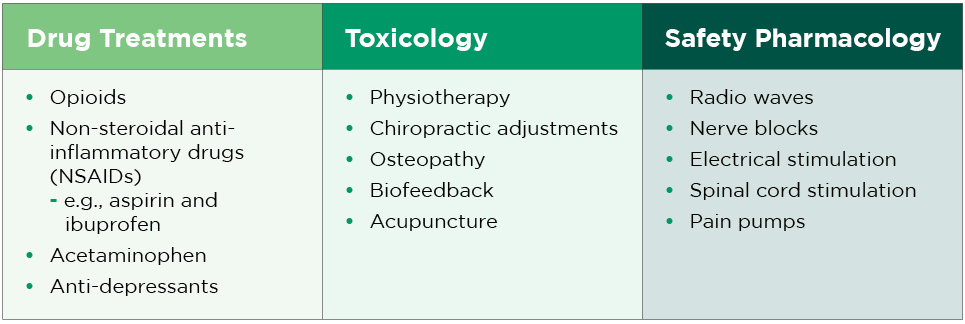New Generation Pain Relief Without Opioids
Opioids are highly effective at relieving both acute and chronic pain. However, this benefit comes at a significant cost: they are also highly addictive. With one in five people suffering from chronic pain in the U.S. and worldwide, solutions are urgently needed. Research is ongoing to discover alternative methods of pain relief as effective as opioids, but with lower human abuse potential.
What Pain Relief Treatments Are Available Now?
Current pain relief options include drug, physical, and high-tech treatments. Patients may see a physiotherapist, osteopath, or chiropractor that relies on physical exercises or manipulation to relieve pain. Physicians may use high-tech treatments like radio waves to short-circuit pain signals by ablating a nerve. Nerves can also be blocked by injecting numbing medications. Other treatment options include transcutaneous electrical nerve stimulation (TENS) or spinal cord stimulation via a device implant. Patients may also have a pump put in place to deliver targeted medication on demand.

Treatments vary in efficacy from one patient to the next, and physical and high-tech treatments can be time-consuming or otherwise difficult to access.
What Are Opioids?
Opioids include naturally occurring alkaloids from the opium poppy (i.e., opiates), semi-synthetic derivatives, and synthetic compounds.

Most opioids act on the mu (µ) receptor to depress breathing, increase pleasure, and block pain. Delta (Δ) and kappa (κ) receptors may also be affected by other opioids. An opioid’s abuse potential depends on its ability to cross the blood-brain barrier, how readily it binds to opioid receptors, and its ease of use.
What Is the Impact of Opioids?
Opioid use, both prescription and illicit, has led to high levels of substance abuse worldwide. The number of deaths in 2019 was over 350,000 worldwide and nearly 50,000 in the U.S. alone.
What Pain Relief Alternatives Are Available Now?
Abuse-deterrent formulations (ADFs) are currently used to mitigate instances of opioid addiction. Strategies include making opioids more difficult to tamper with and discourage users from attempting to convert pills into faster-acting forms of administration like injection or snorting. Some ADFs include irritants or other additives aimed to reduce intranasal administration.
Naloxone, a medication that reverses opioid overdose, is readily available in many communities to those likely to witness overdose. This includes but is not limited to people diagnosed with opioid use disorder, their families and friends, and their healthcare providers.
What New Pain Relief Treatments Are Being Researched and Developed?
Research efforts to replace the current generation of opioids encompass:
Repurposing existing drugs - A receptor playing a pivotal role in cellular communication and the normal function of the nervous system originally implicated in cancer growth has recently found to also play a pivotal role in pain sensitization. This discovery raises the possibility of repurposing existing cancer drugs for chronic pain management.
- New opioid drugs
- Using computer modeling to simulate molecular docking, researchers were able to find novel µ-receptor agonists. In 2016, a team at UCSF School of Pharmacy discovered a molecule that activates the µ receptor without the side effects typical of other opioids.
- New non-opioid drugs
- Sedative drugs like clonidine and dexmedetomidine are sometimes used as alternatives to opioids. They work by acting on the alpha 2A-adrenergic receptor to provide pain relief. Using computer modeling, researchers at UC San Francisco have discovered six novel molecules that act on the same receptor without the sedative effect.
With new treatments on the horizon, there is hope for safe and effective pain relief with lower abuse potential. Altasciences’ pain experts and neuroscientists can assist you in evaluating the efficacy and safety profile of your study drug. Contact them today for more information.
You may also be interested in:
- The Altascientist: Issue 3—Assessing Human Abuse Potential to Limit the Misuse and Abuse of Prescription Drugs
- Fact Sheet: Pain Models
- Video: Navigating the Abuse Potential Evaluation of CNS-Active Drugs for EU and U.S. Submissions
- Podcast: The Many Faces of Recreational Drug Use—Episode 3



